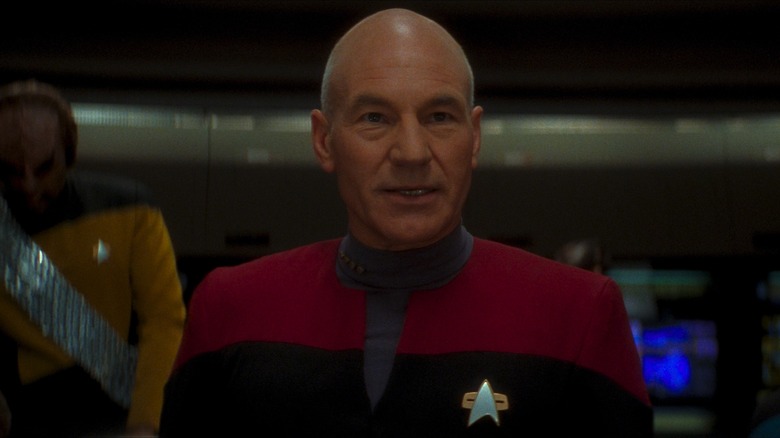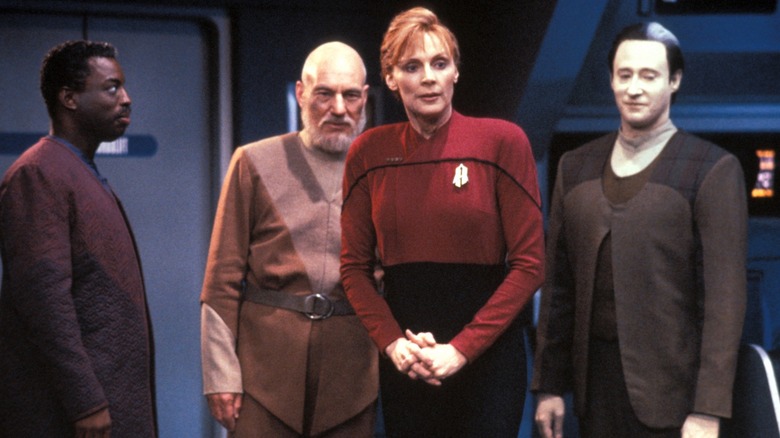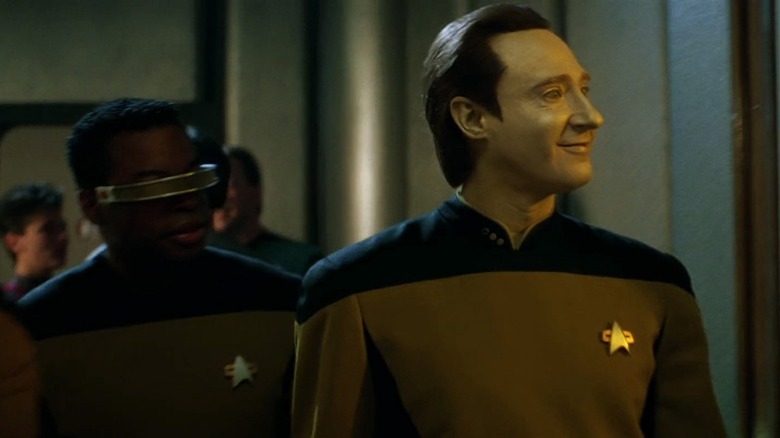Why Star Trek: TNG Writers Kept Mixing Up The Finale With Another Trek Project
According to IMDb, "All Good Things..." — the final episode of "Star Trek: The Next Generation" — filmed on the Paramount lot and around Southern California from March 11, 1994, to April 5. The episode aired on May 23. The final episode made extensive use of the show's many sets, filming on the bridge, in Ten Forward, and throughout various corridors on the Enterprise-D. The series ended with a complex time-travel story, and the implication that the adventures of the Enterprise-D would continue, but that audiences simply wouldn't be allowed to watch them. Had "Star Trek" ended there, I think many Trekkies would have been perfectly content. Or, more likely, we would have happily shifted focus to "Star Trek: Deep Space Nine" which debuted in January of 1993.
Paramount, it seems, wanted "Next Generation" to remain fresh in people's minds, however, and the production of the first "NextGen" feature film, "Star Trek: Generations," overlapped with "All Good Things...". As IMDb says, shooting for "Generations" ran from March 24, 1994 through June 9. That means there was a 12-day period in the life of "Star Trek" that a two-part finale and a two-hour movie were being worked on simultaneously. "Generations" opened on November 18, 1994. To further keep everyone busy, "Deep Space Nine" was already in its third season.
How did the showrunners keep track of everything? As it so happens, barely. In a 2014 "All Good Things..." retrospective with Yahoo! News, writers Ronald D. Moore and Brannon Braga — who penned the scripts for both "All Good Things..." and "Generations" — discussed the ultra-busy year of 1994, and found that they frequently mixed up their series finale with their debut movie.
If it's Tuesday, this must be Veridian III
Trekkies will immediately be able to tell you the differences between "All Good Things..." and "Generations," of course. The finale episode took place over three time periods and featured most of the cast in old-age makeup, as well as the return of Denise Crosby, whose character was infamously killed in the show's first season. "Generations," meanwhile, featured different lighting, new uniforms, and an expanded bridge set for the Enterprise-D. Regardless, to Moore and Braga, they were essentially identical projects. They were both two hours long, they both had the exact same cast, and they both employed the same Paramount sets.
It's worth noting that "Star Trek V: The Final Frontier" and "Star Trek VI: The Undiscovered Country" also made use of the "Next Generation" sets, so the "double duty" approach wasn't wholly new to "Star Trek." It was the first time, though, that Moore admitted being mixed up. He said to Yahoo!:
"There were points where we literally were working and we would suddenly stop and say, 'Wait, which one are we working on?' Because they were both two hours, they took place in the same ship with the same characters ... and every once in a while, you'd just get caught in the moment of, 'Wait a minute, this scene with Geordi in the engine room is from which one?'"
Trekkies will hasten to point out that Geordi had several scenes in the Enterprise's engine room in "Generations," but didn't have any engine room scenes in "All Good Things...," but one can see how Moore would be mixed up.
Braga, meanwhile, was able to separate the two through story conceits.
Data's emotions chip
Both a series finale and a debut feature film are going to want to have more ambitious stories than an average episode of the TV series, so both "All Good Things..." and "Generations" did things that hadn't been tried before. "Things" features flash-forwards to the characters' futures, while "Generations" features a notable character development for Data (Brent Spiner), the android. Throughout "Next Generation," Data struggled with the fact that he couldn't experience human emotions, or at least not common ones like happiness, anger, or fear. Braga found that giving Data emotions was the grand piece of character work that needed to be saved for a movie. Braga said:
"It was an interesting comparison to write a movie and a TV show with the same characters. What we realized was on a TV show, it's like living with your family on a daily basis, and writing a movie is like seeing your family once every four years. You take bigger swings with a movie. Like, we gave Data an emotion chip. You had to do something; it couldn't just be another TV episode. So that's something we learned very quickly ... It sounds like I'm teaching a bad screenwriting class."
So there were a few writerly hints that Moore and Braga left for themselves along the way.
Visually, of course, one might have a hint for the writers, even though it comes 30 years too late. Look at the uniforms on "All Good Things..." vs. the way they looked in "Generations." The communicator badges on the series were silver "delta" shaped superimposed over an oval ellipse. In the movie, the ellipse was replaced by a rectangular golden set of bars. It's a small change, but a clear visual indicator for Trekkies everywhere.


